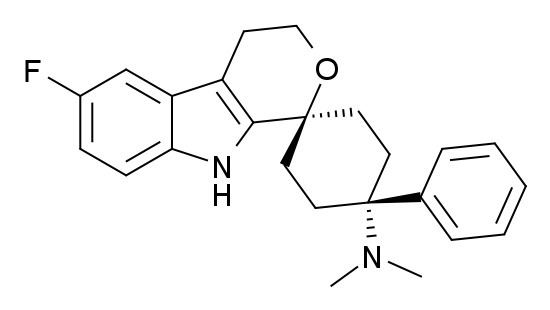ATC code None CAS Number 863513-91-1 ChemSpider 29398942 Formula C24H27FN2O | Biological half-life ~4.5 hours PubChem CID 11848225 3D model (Jmol) Interactive image Molar mass 378.482 g/mol | |
 | ||
IUPAC ID (1r,4r)-6’-fluoro-N,N-dimethyl-4-phenyl-4’,9’-dihydro-3’H-spiro[cyclohexane-1,1’-pyrano[3,4-b]indol]-4-amine | ||
Cebranopadol (GRT-6005) is a novel opioid analgesic of the benzenoid class which is currently under development internationally by Grünenthal, a German pharmaceutical company, and its partner Depomed, a pharmaceutical company in the United States, for the treatment of a variety of different acute and chronic pain states. As of November 2014, it is in phase III clinical trials. Cebranopadol is unique in its mechanism of action as an opioid, binding to and activating all four of the opioid receptors; it acts as a full agonist of the nociceptin receptor (Ki = 0.9 nM; EC50 = 13.0; IA = 89%), μ-opioid receptor (Ki = 0.7 nM; EC50 = 1.2; IA = 104%), and δ-opioid receptor (Ki = 18 nM; EC50 = 110; IA = 105%), and as a partial agonist of the κ-opioid receptor (Ki = 2.6 nM; EC50 = 17; IA = 67%). The ED50 values of 0.5-5.6 µg/kg when introduced IV & 25.1 µg/kg after oral administration.
Cebranopadol shows highly potent and effective antinociceptive and antihypertensive effects in a variety of different animal models of pain. Notably, it has also been found to be more potent in models of chronic neuropathic pain than acute nociceptive pain compared to selective μ-opioid receptor agonists. Relative to morphine, tolerance to the analgesic effects of cebranopadol has been found to be delayed (26 days versus 11 days for complete tolerance). In addition, unlike morphine, cebranopadol has not been found to affect motor coordination or reduce respiration in animals at doses in or over the dosage range for analgesia. As such, it may have improved and prolonged efficaciousness and greater tolerability in comparison to currently available opioid analgesics.
As an agonist of the κ-opioid receptor, cebranopadol may have the capacity to produce psychotomimetic effects and other adverse reactions at sufficiently high doses, a property which could potentially limit its practical clinical dosage range.
